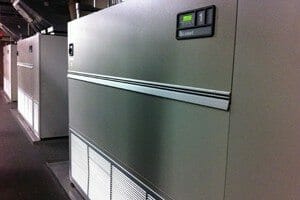Do You Really Need to Buy Another Cooling Unit?9 min read

The development of hotspots is often used as the first indicator for the need to increase cooling capacity. Quite often, once hotspots are detected, additional cooling units are purchased and installed without determining if the problem is the result of a lack of capacity or lack of management of existing resources. In most cases, there’s more cooling capacity installed in a room than data center managers are aware of.
Knowing your potential cooling capacity and how to release stranded capacity can help defer costly capital expenditures, such as purchasing another cooling unit.
Know your Cooling Capacity
The easiest way to make informed decisions about investing in additional cooling capacity is to determine how well you are utilizing your current resources. Calculating your Cooling Capacity Factor (CCF) is the quickest and easiest way to determine cooling infrastructure utilization and potential gains that can be realized (by improving airflow management).
CCF is calculated by dividing the total running manufacturer’s stated cooling capacity (kW) by 110% of the IT critical load (kW).
The total running cooling capacity is the sum of the running cooling units’ rated capacities. If all cooling units are running, then this will be the same value as the total installed rated cooling capacity. For example, if there are 10 cooling units installed with a rated capacity of 30 tons each and seven are running, then the total running cooling capacity is 739 kW (7 x 30 tons = 210 tons, 210 tons x 3.52 = 739 kW). Note: To convert tons to kW, multiply tons by the constant 3.52.
The IT critical load in the room is equal to the UPS output(s) for the room. Ensure that the UPS output used is only for the room being calculated. If the UPS feeds other rooms, then those loads must be subtracted from the total UPS output. To account for typical room load not reflected in the UPS output, add 10% for lights, people, and building envelope.
Release Stranded Capacity
CCF is a direct indicator of stranded cooling capacity in the data center. In most sites, there is excess cooling running in the space while there is inadequate cooling of the IT hardware. Inadequate cooling is when the IT equipment intake temperatures are above or below the standards established by ASHRAE for mission-critical facilities. ASHRAE explicitly states that the recommended range is appropriate for legacy equipment. Determining your CCF reveals whether the root cause of poor intake air temperature is due to a lack of capacity or poor airflow management.
Address Bypass Airflow
The biggest cause of stranded capacity is bypass airflow — supply air from the cooling units not passing through IT equipment before returning to the cooling units. Minimizing bypass airflow is fundamental to optimizing cooling infrastructure.
You can estimate bypass airflow by multiplying the UPS load by 120, the industry average for CFM/kW of IT load. This is the required airflow in CFM for the IT load. Compare this to the airflow delivered by the running cooling units and you will likely find that the room is dramatically oversupplied with conditioned air. (The manufacturer’s specifications provides cooling unit airflow volume data.) Another inefficiency indicator is to compare the supply air temperature from the cooling units to some of the highest rack intake air temperatures. If there is a temperature increase, it is the result of hot exhaust air from the IT load contaminating cooling supply air.
Other important metrics to calculate before deciding to buy another unit:
- Bypass open area
- Proper perforated tile placement
- Blanking panel use
- Rail seals
Conclusion
If hotspots are developing in your data center, it’s either due to a lack of capacity or lack of management of the existing resources. If the site is in good shape in regards to the aforementioned metrics, then it’s likely that additional capacity needs to be added, however in most cases, simply improving airflow management will release more than sufficient capacity to handle increases in IT load. So the next time you’re considering to increase your computer room’s cooling capacity, you may want to ask yourself, “Do I really need to buy another cooling unit?”

Airflow Management Awareness Month
Free Informative webinars every Tuesday in June.
0 Comments